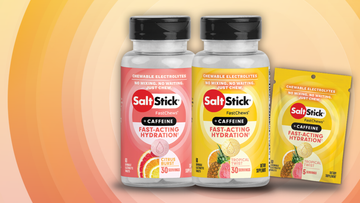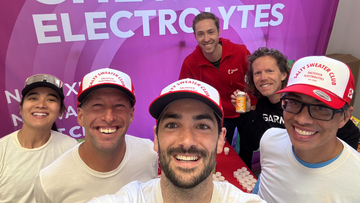The hydration process is one of the more fascinating things about endurance nutrition. Specifically the fact that hydration is based on
ratios and not absolute values. While it’s true that every nutrition label provides a set amount of sodium and potassium to consume each day, those nutrition labels also list the disclaimer that the numbers are “based on a diet of 2,000 calories per day.” In other words, the amount of suggested sodium and potassium is in relation to everything else you eat.
What is ratio-based nutrition?
A good example of ratio-based nutrition is the treatment high blood pressure patients. For the past 20 years,
scientists have found that people with high blood pressure who don’t want to lower their salt intake can simply consume more potassium-containing foods (such as bananas, potatoes or berries). Why? Because the
balance of the two minerals is what matters. In fact, Dutch researchers determined that a low potassium intake has the same impact on your blood pressure as high sodium consumption. It's also worth noting that high sodium intake does not cause high blood pressure in everybody, in fact, only in a small minority of people.
This balance relates to much more than sodium and potassium. Optimal contents of sodium and water are ratio-based. The four major electrolytes are ratio-based (The average person sweats a salt ratio of 220 Sodium to 63 Potassium to 16 Calcium to 8 Magnesium). Even your body’s alkalinity is ratio-based (as a pH measurement is really just a ratio of H+ ions to OH- ions).
Why ratios? The simplest way to look at it is that people come in all shapes and sizes and with unique physiology. Absolute numbers- whether intake or loss of nutrients, would be a limiting concept: too little for people who need more, and too much for those who need less. Our body's physiology is generally maintained via homeostasis. Via external supplementation, a fix for too much sodium is simply to consume more water, and the sodium-to-water ratio is naturally restored. The same goes for the blood-pressure patients who may need more potassium. If one consumes too much water (which can lead to
hyponatremia, a more dangerous condition than dehydration), one would need to eat more sodium. At the end of the day, hydration is about maintaining an optimal
balance of water and electrolytes by allowing our bodies to utilize evolutionarily-developed systems of homeostasis, along with supplying our body with proper building blocks.
An article about the ratio of water and salt was previously published on
Slowtwitch.com.
Success in applying ratio-based nutrition:
What does this mean for the endurance athlete? With all this talk of ratios and balance, rehydration practices can seem overwhelming. How could someone possibly keep track of sodium-to-potassium ratios, especially during a hard workout where math-related cognition isn’t exactly at 100 percent? Lucky for you, there’s no need to draft complicated charts for your workouts -- because we’ve done that for you! Like we said above, sodium, potassium, calcium and magnesium are lost in a 220-63-16-8 ratio for the average athlete. To ensure the full spectrum of electrolytes is replaced,
a SaltStick Capsule conveniently provides the same ratio, and in a form and quantity the body can absorb. While the exact ratio also varies from person-to-person, supplying your body with building blocks in about the right amount is key.
How you can take advantage of the optimal ratios in SaltStick Caps:
It’s still important to understand that sweat rates and electrolyte needs are unique to each person, so you’ll need to play around with ideal dose. Some people need a lower salt-to-water ratio than others. Some people (called “heavy sweaters”) need more salt AND water overall. We provide a good overview of how your sweat rate plays into your nutrition needs on our website here (“
SaltStick Research”), but essentially, light sweaters or smaller individuals should consider 1 SaltStick Cap per hour. Heavy sweaters, larger individuals, or those in hotter conditions should consider 2-3 SaltStick Caps per hour. The best strategy for success is to practice your nutrition strategy during training so you can optimize for what works for you, and then execute that during racing. We provide a complete suggested usage guide here:
Training with SaltStick Capsules.
There’s not much more thinking required on your part. Ratios are great because they’re intuitive, and SaltStick Caps allow you to focus on your training or racing, and not on doing math in your head! After you adjust your SaltStick Caps and water intake based on the conditions and your unique needs, you’re free to accomplish what you set out to do: get in an awesome workout or race! No thoughts about ratios. No worries of becoming dehydrated. No lists you’ll need to follow.
Happy training!








